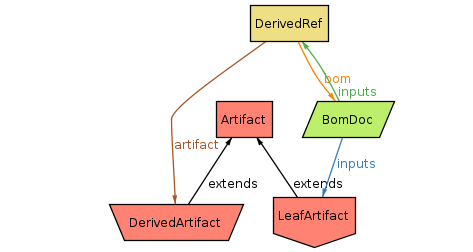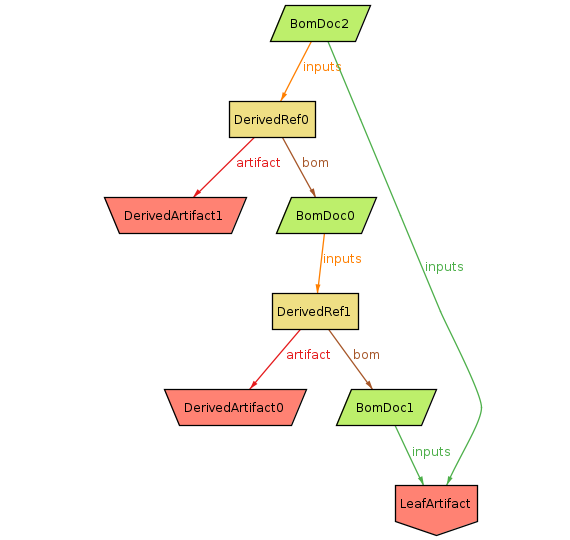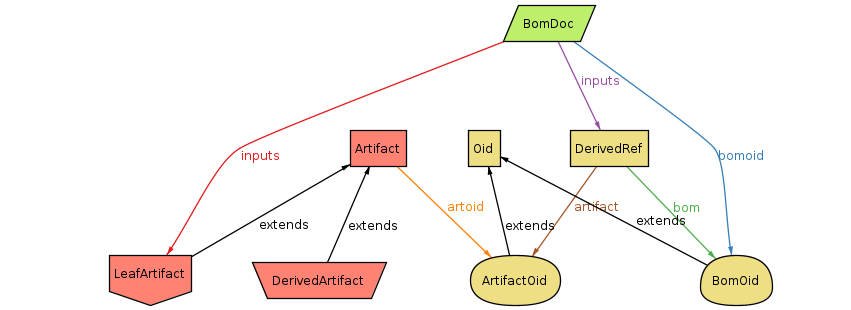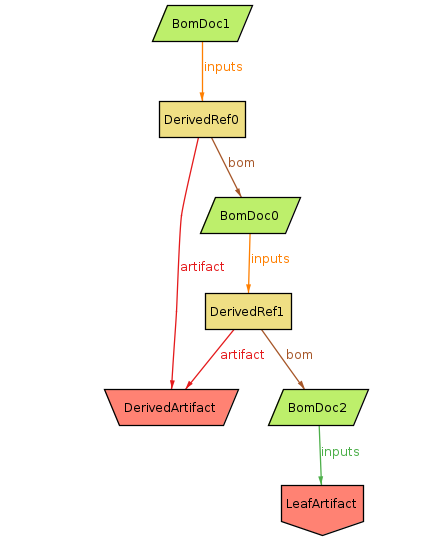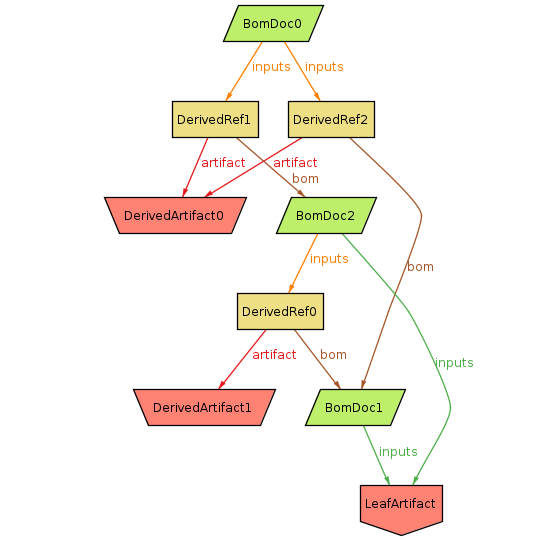Alloy model for gitbom
I've been trying to use Alloy to specify gitbom. This is mostly for my own understanding, but it's also useful for shaking out any imprecision.
I'm basing this off the glossary pages:
and it's intended to reflect the current design.
The simplified spec has objects directly reference each other. In this model, OIDs are implicit. That is, we're just assuming that every addressible object has a distinct OID, but we don't care at all about what form they take.
The meta-model is as follows:
- Two types of
Artifactwhich represents a chunk of bytes. They're divided into two subtypes (though somewhat arbitrarily - see below):LeafArtifactwhich is typically human-written or at least external to this build process.DerivedArtifactwhich is generated by some build step.
BomDoc(aka "GitBOM Document"), which is a set of references to inputs.LeafArtifactscan be referenced directly.DerivedRefmediates references toDerivedArtifacts, because they're also tied to theBomDocfor the build step which generated it.
An example instance of this model:
The more detailed spec explicitly includes OIDs. This is closer to the real system, but the OIDs add a lot of extra complexity. However, once we start to consider how to handle constructing OIDs with multiple hash functions, we'll need the explicit representation.
TODO: This is pretty rough - most of my focus has been on the implicit OID version.
With an example instance:
This is just a snapshot of my understanding of the writeup on gitbom.dev — I could easily have got things wrong. Some misc things I noticed.
GitBOM documents (BomDocs) only encode input artifacts. But they do not encode what build action was actually taken, nor what outputs were generated. So two different build actions producing different derived output artifacts would reference the same BomDoc.
Related to this, there's no real way of distinguishing how many actions were
run, or what outputs they had, except by looking for all the derived
artifact+bom references (DerivedRef here) which exist in the graph.
I think this means that the BomDoc needs to either encode - as part of its identity - either what the build action was, or what the output artifacts were. Since the output artifacts are more important as far as determining provenance is concerned, they're probably preferable. (Unless you can guarantee deterministic output from tools, the build action on its own is not enough anyway.)
One not immediately obvious constraint was that a BomDoc cannot depend on a
given derived artifact and another BomDoc which also depends on that derived
artifact (this is a stronger constraint than acyclic BomDoc graph). For example, here BomDoc0 depends on DerivedArtifact which was apparently generated by BomDoc2, but BomDoc1 also depends on DerivedArtifact and BomDoc0:
(Though actually, since DerivedArtifact just represents a pattern of bits,
there's no particular reason why BomDoc2 and BomDoc0 couldn't both
independently generate the same bits, even if they have a dependency
relationship. So maybe the real constraint is just that the BomDocs themselves
can't be cyclic.)
Also here's an example of a BomDoc depending on a derived artifact twice, generated by two different build actions. Presumably this is a case where two actions ended up producing identical outputs, and a third action ends up depending on both.
One way this could arise is if DerivedArtifact0 were actually something simple
like an empty file - it's easy to imagine two separate actions both emitting
that. But of course there are also possibilities where it could be a non-trivial
file.
Since artifacts are entirely defined by their content, a given set of bytes can
be both derived and a leaf if they happen to have the same content. This spec
keeps the distinction for clarity, but it might actually be misleading. It would
be strictly more accurate to use plain Artifact everywhere.
- I assume a GitBOM document must have at least one input (and one output if we're also recording those).
Alloy is a formal specification and validation tool. It allows you to specify a system by describing entities, and the relationships between them with various constraints. It is a high-level and somewhat abstract tool, which means that the specifications tend to be quite terse compared to a conventional programming language.
The most basic way of using the tool is to define a spec and have it generate random instances of that spec which it displays graphically (all the diagrams in this doc are directly from Alloy's GUI). I find it extremely useful to just keep doing this to get an intuition about the structure, and use it to refine the spec ("Oh, that shouldn't be happening...").
More advanced uses include defining invariants (ie things you believe ought to be always true given the spec) and have Alloy try to find counter-examples. And you can also use it to model mutations to a structure to make sure the invariants are maintained over abitrary sequences of operations.
Resources:
I found the book to be pretty good, though it's a little out of date with respect to the current release (but all the fundamentals are still important and useful). The third-party docs by Hillel Wayne are up to date and very useful reference.
